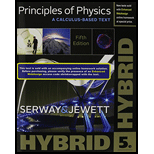
(a)
The resistance of the wires and the corresponding values of the resistivity.
(a)
Answer to Problem 76P
The resistance of wire 1 is
Explanation of Solution
Given information: Area of cross section of gauge wire is
Formula to calculate the resistance of wire 1.
Here,
Substitute
Thus, the resistance of wire 1 is
Formula to calculate the resistivity of wire 1.
Here,
Substitute
Thus, the resistivity of wire 1 is
Formula to calculate the resistance of wire 2.
Here,
Substitute
Thus, the resistance of wire 2 is
Formula to calculate the resistivity of wire 2.
Here,
Substitute
Thus, the resistivity of wire 2 is
Formula to calculate the resistance of wire 3.
Here,
Substitute
Thus, the resistance of wire 3 is
Formula to calculate the resistivity of wire 3.
Here,
Substitute
Thus, the resistivity of wire 3 is
Conclusion:
Therefore, the resistance of wire 1 is
(b)
The average value of resistivity.
(b)
Answer to Problem 76P
The average value of resistivity is
Explanation of Solution
Given information: Area of cross section of gauge wire is
Formula to calculate the average value of resistivity.
Here,
Substitute
Thus, the average value of resistivity is
Conclusion:
Therefore, the average value of resistivity is
(c)
The way in which this average value of resistivity compares with the value given in the table 26.2.
(c)
Answer to Problem 76P
This average value of resistivity compares with the value given in the table 26.2. It is observed that the average value of the resistivity is equal to the resistivity of the nichrome. So, a experiment is done by the student to measure the electrical resistance of Nichrome in the form of wires of different lengths and cross sectional areas is correct.
Explanation of Solution
Given information: Area of cross section of gauge wire is
The average value of resistivity is
The value of resistivity of Nichrome is ranging from
It is observed that the average value of the resistivity is equal to the resistivity of the nichrome. So, a experiment is done by the student to measure the electrical resistance of Nichrome in the form of wires of different lengths and cross sectional areas is correct.
Thus, this average value of resistivity compares with the value given in the table 26.2. It is observed that the average value of the resistivity is equal to the resistivity of the nichrome. So, a experiment is done by the student to measure the electrical resistance of Nichrome in the form of wires of different lengths and cross sectional areas is correct.
Conclusion:
Therefore, this average value of resistivity compares with the value given in the table 26.2. It is observed that the average value of the resistivity is equal to the resistivity of the nichrome. So, a experiment is done by the student to measure the electrical resistance of Nichrome in the form of wires of different lengths and cross sectional areas is correct.
Want to see more full solutions like this?
Chapter 21 Solutions
Principles of Physics: A Calculus-Based Text, Hybrid (with Enhanced WebAssign Printed Access Card)
- An object is placed 24.1 cm to the left of a diverging lens (f = -6.51 cm). A concave mirror (f= 14.8 cm) is placed 30.2 cm to the right of the lens to form an image of the first image formed by the lens. Find the final image distance, measured relative to the mirror. (b) Is the final image real or virtual? (c) Is the final image upright or inverted with respect to the original object?arrow_forwardConcept Simulation 26.4 provides the option of exploring the ray diagram that applies to this problem. The distance between an object and its image formed by a diverging lens is 5.90 cm. The focal length of the lens is -2.60 cm. Find (a) the image distance and (b) the object distance.arrow_forwardPls help ASAParrow_forward
 Principles of Physics: A Calculus-Based TextPhysicsISBN:9781133104261Author:Raymond A. Serway, John W. JewettPublisher:Cengage Learning
Principles of Physics: A Calculus-Based TextPhysicsISBN:9781133104261Author:Raymond A. Serway, John W. JewettPublisher:Cengage Learning
 College PhysicsPhysicsISBN:9781305952300Author:Raymond A. Serway, Chris VuillePublisher:Cengage Learning
College PhysicsPhysicsISBN:9781305952300Author:Raymond A. Serway, Chris VuillePublisher:Cengage Learning College PhysicsPhysicsISBN:9781285737027Author:Raymond A. Serway, Chris VuillePublisher:Cengage Learning
College PhysicsPhysicsISBN:9781285737027Author:Raymond A. Serway, Chris VuillePublisher:Cengage Learning Physics for Scientists and Engineers: Foundations...PhysicsISBN:9781133939146Author:Katz, Debora M.Publisher:Cengage Learning
Physics for Scientists and Engineers: Foundations...PhysicsISBN:9781133939146Author:Katz, Debora M.Publisher:Cengage Learning Physics for Scientists and Engineers, Technology ...PhysicsISBN:9781305116399Author:Raymond A. Serway, John W. JewettPublisher:Cengage Learning
Physics for Scientists and Engineers, Technology ...PhysicsISBN:9781305116399Author:Raymond A. Serway, John W. JewettPublisher:Cengage Learning





